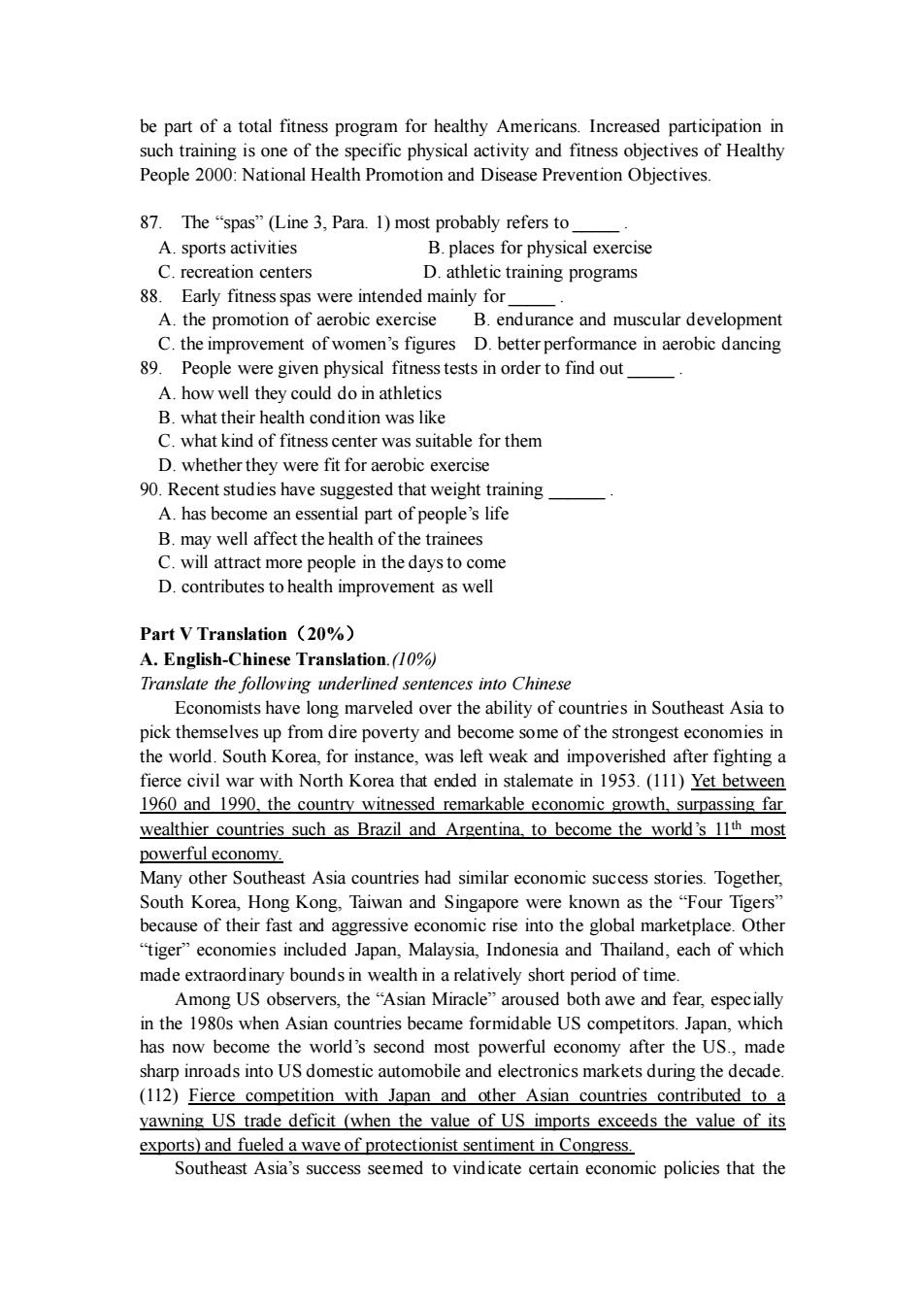正在加载图片...

be part of a total fitness program for healthy Americans.Increased participation in uch tr one of the specific physical activity a of Healthy Peos 200 Natonal Hea Promo 87.The "spas"(Line 3.Para.1)most probably refers to A sports activities B.places for physical exercise reation centers D.athletic training program 88. Early fitness spas were intended mainly fo A.the promotion of aerobic exercise B.endurance and muscular development C.the improvement of women's figures D.better performance in aerobic dancing 89.People were given physical fitness tests in order to find out A.how well they could do in athletics B.what their C.what kind of fitness center was suitable for them D.whether they were fit for aerobic exercise 90.Recent studies have suggested that weight training A.has become an essential part of people's life well affect the heatho trainees D.contributes to health improvement as well Part V Translation (20%) A.English-Chinese Translation.(/0%) Translate the following uderlined sentences into Chinese Economists have long marveled over the ability of countres in Southeast Asia to pick themselves up from dire poverty and become some of the strongest economies in the world.South Korea,for instance,was left weak and impoverished after fighting a fierce civil war with North Korea that ended in stalemate in 1953.(111)Yet between 1960 and 1990,the co essed remarkable economic growth assing far wealthier countries such as Brazil and Argentina,to become the world's most powerful economy. Many other Southeast Asia countries had similar economic success stories.Together, South Korea,Hong Kong.Taiwan and Singapore were known as the "Four Tigers" because of their fast and aggressive economic rise into the global marketplace.Other tiger"included Japan,Malaysia,Indonesia and Thailand, eac n of which made extraordinary bounds in wealth in a relatively short period of time Among US observers,the"Asian Miracle"aroused both awe and fear,especially in the 1980s when Asian countries became formidable US competitors.Japan,which has now become the world's seond most powerful econm after the US made nroads into US do automobile and elect nics marketsdurin de (112)Fierce competition with Japan and other Asian countries contributed to a yawning US trade deficit (when the value of US imports exceeds the value of its exports)and fueled a wave of protectionist sentiment in Congress. Southeast asia's success seemed to vindicate certain economic policies that the be part of a total fitness program for healthy Americans. Increased participation in such training is one of the specific physical activity and fitness objectives of Healthy People 2000: National Health Promotion and Disease Prevention Objectives. 87. The “spas” (Line 3, Para. 1) most probably refers to _____ . A. sports activities B. places for physical exercise C. recreation centers D. athletic training programs 88. Early fitnessspas were intended mainly for _____ . A. the promotion of aerobic exercise B. endurance and muscular development C. the improvement of women’s figures D. better performance in aerobic dancing 89. People were given physical fitnesstests in order to find out _____ . A. how well they could do in athletics B. what their health condition was like C. what kind of fitness center was suitable for them D. whether they were fit for aerobic exercise 90. Recent studies have suggested that weight training ______ . A. has become an essential part of people’s life B. may well affect the health of the trainees C. will attract more people in the days to come D. contributes to health improvement as well Part V Translation(20%) A. English-Chinese Translation.(10%) Translate the following underlined sentences into Chinese Economists have long marveled over the ability of countries in Southeast Asia to pick themselves up from dire poverty and become some of the strongest economies in the world. South Korea, for instance, was left weak and impoverished after fighting a fierce civil war with North Korea that ended in stalemate in 1953. (111) Yet between 1960 and 1990, the country witnessed remarkable economic growth, surpassing far wealthier countries such as Brazil and Argentina, to become the world’s 11th most powerful economy. Many other Southeast Asia countries had similar economic success stories. Together, South Korea, Hong Kong, Taiwan and Singapore were known as the “Four Tigers” because of their fast and aggressive economic rise into the global marketplace. Other “tiger” economies included Japan, Malaysia, Indonesia and Thailand, each of which made extraordinary bounds in wealth in a relatively short period of time. Among US observers, the “Asian Miracle” aroused both awe and fear, especially in the 1980s when Asian countries became formidable US competitors. Japan, which has now become the world’s second most powerful economy after the US., made sharp inroads into US domestic automobile and electronics markets during the decade. (112) Fierce competition with Japan and other Asian countries contributed to a yawning US trade deficit (when the value of US imports exceeds the value of its exports) and fueled a wave of protectionist sentiment in Congress. Southeast Asia’s success seemed to vindicate certain economic policies that the